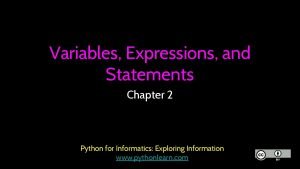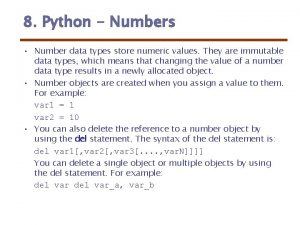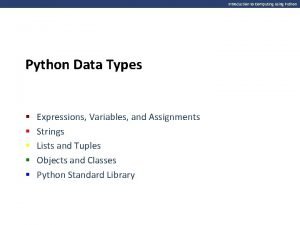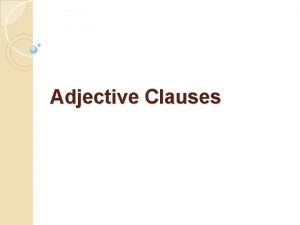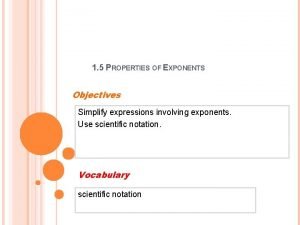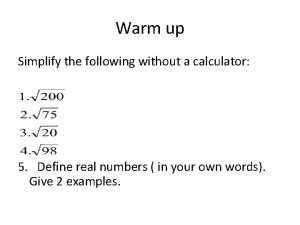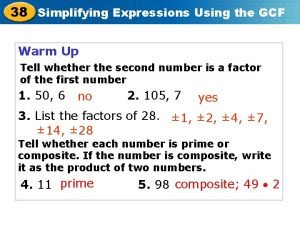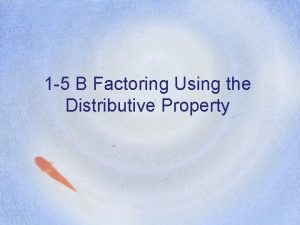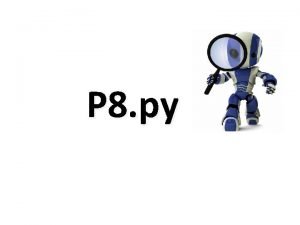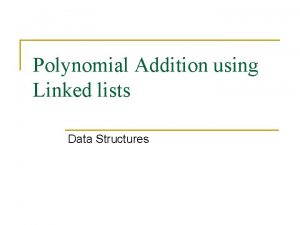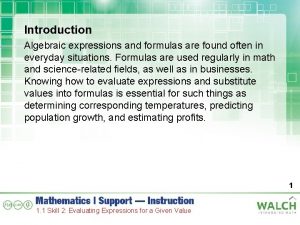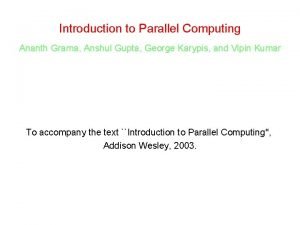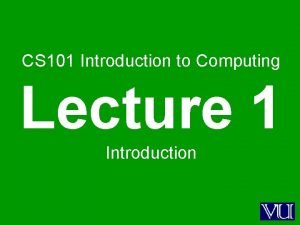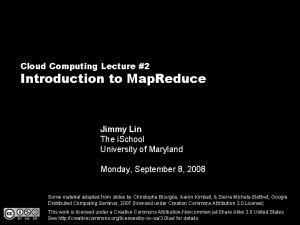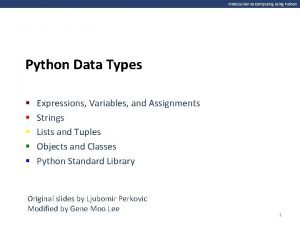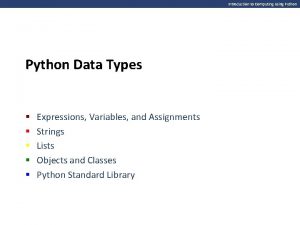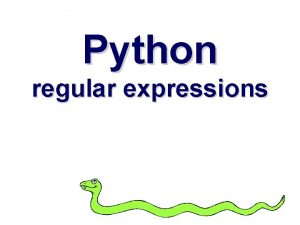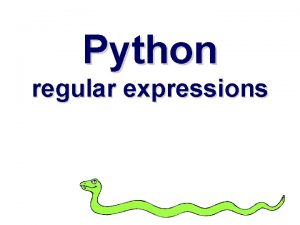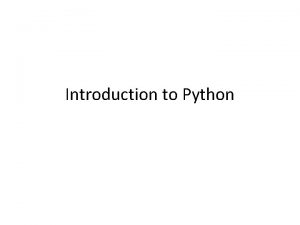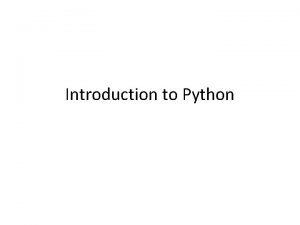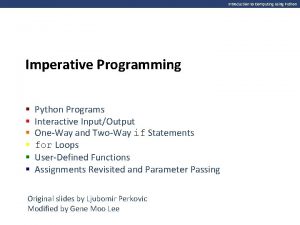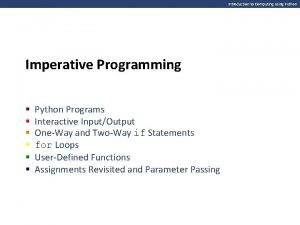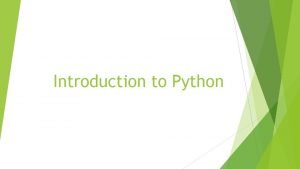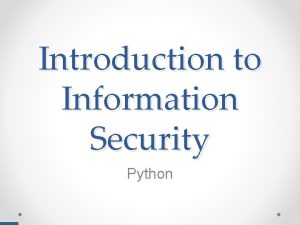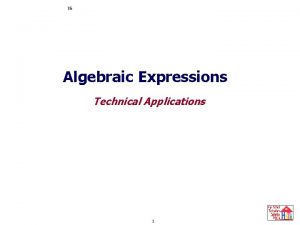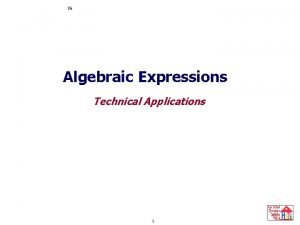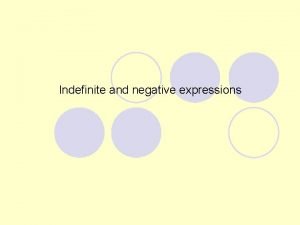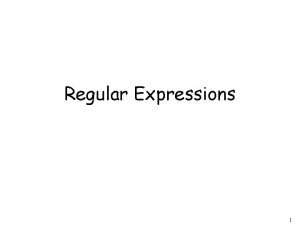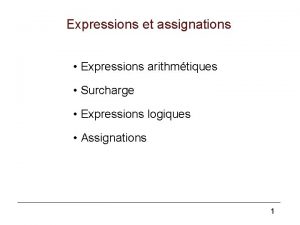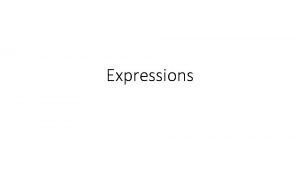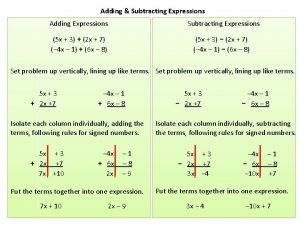Introduction to Computing Using Python Data Types Expressions





























- Slides: 29

Introduction to Computing Using Python Data Types § § § Expressions, Variables, and Assignments Strings Lists and Tuples Objects and Classes Python Standard Library

Introduction to Computing Using Python Algebraic expressions The Python interactive shell can be used to evaluate algebraic expressions 14//3 is the quotient when 14 is divided by 3 and 14%3 is the remainder 2**3 is 2 to the 3 rd power abs(), min(), and max() are functions • abs() takes a number as input and returns its absolute value • min() (resp. , max()) take an arbitrary number of inputs and return the “smallest” (resp. , “largest”) among them >>> 2 + 3 5 >>> 7 - 5 2 >>> 2*(3+1) 8 >>> 5/2 2. 5 >>> 5//2 2 >>> 14//3 4 >>> 14%3 2 >>> 2**3 8 >>> abs(-3. 2) 3. 2 >>> min(23, 41, 15, 24) 15 >>> max(23, 41, 15, 24) 41

Introduction to Computing Using Python Boolean expressions In addition to algebraic expressions, Python can evaluate Boolean expressions • Boolean expressions evaluate to True or False • Boolean expressions often involve comparison operators <, >, ==, !=, <=, and >= >>> 2 < 3 True >>> 2 > 3 False >>> 2 == 3 False >>> 2 != 3 True >>> 2 <= 3 True >>> 2 >= 3 False >>> 2+4 == 2*(9/3) True In a an expression containing algebraic and comparison operators: • Algebraic operators are evaluated first • Comparison operators are evaluated next

Introduction to Computing Using Python Boolean operators In addition to algebraic expressions, Python can evaluate Boolean expressions • Boolean expressions evaluate to True or False • Boolean expressions may include Boolean operators and, or, and not >>> 2<3 and 3<4 True >>> 4==5 and 3<4 False >>> False and True False >>> True and True >>> 4==5 or 3<4 True >>> False or False >>> not(3<4) False >>> not(True) False >>> not(False) True >>> 4+1==5 or 4 -1<4 True In a an expression containing algebraic, comparison, and Boolean operators: • Algebraic operators are evaluated first • Comparison operators are evaluated next • Boolean operators are evaluated last

Introduction to Computing Using Python Exercise Translate the following into Python algebraic or Boolean expressions and then evaluate them: a) The difference between Annie’s age (25) and Ellie’s (21) b) The total of $14. 99, $27. 95, and $19. 83 c) The area of a rectangle of length 20 and width 15 d) 2 to the 10 th power e) The minimum of 3, 1, 8, -2, 5, -3, and 0 f) 3 equals 4 -2 g) The value of 17//5 is 3 h) The value of 17%5 is 3 i) 284 is even j) 284 is even and 284 is divisible by 3 k) 284 is even or 284 is divisible by 3 >>> 25 - 21 4 >>> 14. 99 + 27. 95 + 19. 83 62. 769999996 >>> 20*15 300 >>> 2**10 1024 >>> min(3, 1, 8, -2, 5, -3, 0) -3 >>> 3 == 4 -2 False >>> 17//5 == 3 True >>> 17%5 == 3 False >>> 284%2 == 0 True >>> 284%2 == 0 and 284%3 == 0 False >>> 284%2 == 0 or 284%3 == 0 True

Introduction to Computing Using Python Variables and assignments Just as in algebra, a value can be assigned to a variable, such as x When variable x appears inside an expression, it evaluates to its assigned value A variable (name) does not exist until it is assigned The assignment statement has the format <variable> = <expression> is evaluated first, and the resulting value is assigned to variable <variable> >>> x = 3 >>> x 3 >>> 4*x 16 >>> y Traceback (most recent call last): File "<pyshell#59>", line 1, in <module> y Name. Error: name 'y' is not defined >>> y = 4*x >>> y 16. 0

Introduction to Computing Using Python Naming rules (Variable) names can contain these characters: • a through z • A through Z • the underscore character _ • digits 0 through 9 Names cannot start with a digit though For a multiple-word name, use • either the underscore as the delimiter • or camel. Case capitalization Short and meaningful names are ideal >>> My_x 2 = 21 >>> My_x 2 21 >>> 2 x = 22 Syntax. Error: invalid syntax >>> new_temp = 23 >>> new. Temp = 23 >>> counter = 0 >>> temp = 1 >>> price = 2 >>> age = 3

Introduction to Computing Using Python Strings In addition to number and Boolean values, Python support string values "Hello, World!" 'Hello, World!' A string value is represented as a sequence of characters enclosed within quotes A string value can be assigned to a variable String values can be manipulated using string operators and functions >>> 'Hello, World!' >>> s = 'rock' >>> t = 'climbing' >>>

Introduction to Computing Using Python String operators Usage Explanation x in s x is a substring of s x not in s x is not a substring of s s + t Concatenation of s and t s * n, n * s Concatenation of n copies of s s[i] Character at index i of s len(s) (function) Length of string s To view all operators, use the help() tool >> help(str) Help on class str in module builtins: class str(object) | str(string[, encoding[, errors]]) -> str. . . >>> 'Hello, World!' >>> s = 'rock' >>> t = 'climbing' >>> s == 'rock' True >>> s != t True >>> s < t False >>> s > t True >>> s + t 'rockclimbing' >>> s + ' ' + t 'rock climbing' >>> 5 * s 'rockrockrock' >>> 30 * '_' '_______________' >>> 'o' in s True >>> 'o' in t False >>> 'bi' in t True >>> len(t) 8

Introduction to Computing Using Python Exercise Write Python expressions involving strings s 1, s 2, and s 3 that correspond to: a) 'll' appears in s 3 b) the blank space does not appear in s 1 c) the concatenation of s 1, s 2, and s 3 d) the blank space appears in the concatenation of s 1, s 2, and s 3 e) the concatenation of 10 copies of s 3 f) the total number of characters in the concatenation of s 1, s 2, and s 3 >>> s 1 'good' >>> s 2 'bad' >>> s 3 'silly' >>> 'll' in s 3 True >>> ' ' not in s 1 True >>> s 1 + s 2 + s 3 'goodbadsilly’ >>> ' ' in s 1 + s 2 + s 3 False >>> 10*s 3 'sillysillysillysilly' >>> len(s 1+s 2+s 3) 12 >>>

Introduction to Computing Using Python Index and indexing operator The index of an item in a sequence is its position with respect to the first item • The first item has index 0, • The second has index 1, • The third has index 2, … s = 'A p p l e' 0 s[0] = s[1] = s[2] = s[3] = s[4] = 1 2 3 4 The indexing operator [] takes a nonnegative index i and returns a string consisting of the single character at index i 'A' 'p' 'l' 'e' >>> s = 'Apple' >>> s[0] 'A' >>> s[1] 'p' >>> s[4] 'e'

Introduction to Computing Using Python Negative index A negative index is used to specify a position with respect to the “end” • The last item has index -1, • The second to last item has index -2, • The third to last item has index -3, … -5 s = -4 -3 -2 'A p p l e' 0 1 2 3 4 'e' s[-1] = 'l' s[-2] = s[-5] = -1 'A' >>> s = 'Apple' >>> s[-1] 'e' >>> s[-2] 'l' >>> s[-5] 'A'

Introduction to Computing Using Python Exercise String s is defined to be 'abcdefgh' Write expressions using s and the indexing operator [] that return the following strings: a) 'a' b) 'c' c) 'h' d) 'f' >>> s = 'abcdefgh' >>> s[0] 'a' >>> s[2] 'c' >>> s[7] 'h' >>> s[-1] 'h' >>> s[-3] 'f' >>>

Introduction to Computing Using Python Lists In addition to number, Boolean, and string values, Python supports lists ['ant', 'bat', 'cod', 'dog', 'elk'] [0, 1, 2, 3, 4, 5, 6, 7, 8, 9, 10] [0, 1, 'two', 'three', [4, 'five']] A comma-separated sequence of items enclosed within square brackets The items can be numbers, strings, and even other lists >>> pets = ['ant', 'bat', 'cod', 'dog', 'elk'] >>> pets = ['ant', 'bat', 'cod', 'dog', 'elk’] >>> lst = [0, 1, 'two', 'three', [4, 'five']] >>> nums = [0, 1, 2, 3, 4, 5, 6, 7, 8, 9, 10] >>>

Introduction to Computing Using Python List operators and functions Like strings, lists can be manipulated with operators and functions Usage Explanation x in lst x is an item of lst x not in lst x is not an item of lst + lst. B Concatenation of lst and lst. B lst*n, n*lst Concatenation of n copies of lst[i] Item at index i of lst len(lst) Number of items in lst min(lst) Minimum item in lst max(lst) Maximum item in lst sum(lst) Sum of items in lst >>> lst = [1, 2, 3] >>> lst. B = [0, 4] >>> 4 in lst False >>> 4 not in lst True >>> lst + lst. B [1, 2, 3, 0, 4] >>> 2*lst [1, 2, 3, 1, 2, 3] >>> lst[0] 1 >>> lst[1] 2 >>> lst[-1] 3 >>> len(lst) 3 >>> min(lst) 1 >>> max(lst) 3 >>> sum(lst) 6 >>> help(list. . .

Introduction to Computing Using Python Lists are mutable, strings are not Lists can be modified; they are said to be mutable pets = ['ant', 'bat', 'cow', 'dog', 'elk'] pets = ['ant', 'bat', 'cod', 'dog', 'elk'] Strings can’t be modified; they are said to be immutable pet = 'cod' >>> pets = ['ant', 'bat', 'cod', 'dog', 'elk'] >>> pets[2] = 'cow' The elements can be numbers, strings, and even other lists >>> pets ['ant', 'bat', 'cow', 'dog', 'elk'] >>> pets = ['ant', 'bat', 'cod', 'dog', 'elk’] >>> pet = 'cod' >>> lst = [0, 1, 'two', 'three', [4, 'five']] >>> >>> pet[2] = 'w' >>> Traceback (most recent call last): File "<pyshell#155>", line 1, in <module> pet[2] = 'w' Type. Error: 'str' object does not support item assignment >>>

Introduction to Computing Using Python Lists methods len()and sum() are examples of functions that can be called with a list input argument; they can also be called on other type of input argument(s) There also functions that are called on a list; such functions are called list methods lst. append(7) variable lst refers to a list object input argument 7 list method append() >>> lst = [1, 2, 3] >>> len(lst) 3 >>> sum(lst) 6 >>> lst. append(7) >>> lst [1, 2, 3, 7] ` >>> Method append() can’t be called independently; it must be called on some list object

Introduction to Computing Using Python Lists methods Usage Explanation lst. append(item) adds item to the end of lst. count(item) returns the number of times item occurs in lst. index(item) Returns index of (first occurrence of) item in lst. pop() Removes and returns the last item in lst. remove(item) Removes (the first occurrence of) item from lst. reverse(item) Reverses the order of items in lst. sort(item) Sorts the items of lst in increasing order Methods append(), remove(), reverse(), and sort() do not return any value; they, along with method pop(), modify list lst >>> lst = [1, 2, 3] >>> lst. append(7) >>> lst. append(3) >>> lst [1, 2, 3, 7, 3] >>> lst. count(3) 2 >>> lst. remove(2) >>> lst [1, 3, 7, 3] >>> lst. reverse() >>> lst [3, 7, 3, 1] >>> lst. index(3) 0 >>> lst. sort() >>> lst [1, 3, 3, 7] >>> lst. remove(3) >>> lst [1, 3, 7] >>> lst. pop() 7 >>> lst [1, 3]

Introduction to Computing Using Python Exercise List lst is a list of prices for a pair of boots at different online retailers a) You found another retailer selling the boots for $160. 00; add this price to list lst b) Compute the number of retailers selling the boots for $160. 00 c) Find the minimum price in lst d) Using c), find the index of the minimum price in list lst e) Using c) remove the minimum price from list lst f) Sort list lst in increasing order >>> lst = [159. 99, 160. 00, 205. 95, 128. 83, 175. 49] >>> lst. append(160. 00) >>> lst. count(160. 00) 2 >>> min(lst) 128. 83 >>> lst. index(128. 83) 3 >>> lst. remove(128. 83) >>> lst [159. 99, 160. 0, 205. 95, 175. 49, 160. 0] >>> lst. sort() >>> lst [159. 99, 160. 0, 175. 49, 205. 95] >>>

Introduction to Computing Using Python Built-in class tuple The class tuple is the same as class list … except that it is immutable >>> lst = ['one', 'two', 3] >>> lst[2] 3 >>> lst[2] = 'three' >>> lst ['one', 'two', 'three'] >>> tpl = ('one', 'two', 3) >>> tpl[2] 3 >>> tpl[2] = 'three' Traceback (most recent call last): File "<pyshell#131>", line 1, in <module> tpl[2] = 'three' Type. Error: 'tuple' object does not support item assignment >>> Why do we need it? Sometimes, we need to have an “immutable list”.

Introduction to Computing Using Python Objects and classes In Python, every value, whether a simple integer value like 3 or a more complex value, such as the list ['hello', 4, 5] is stored in memory as an object. Every object has a value and a type; It is the object that has a type, not the variable! >>> a = 3 >>> b = 3. 0 >>> c = 'three' >>> d = [1, 2, 3] >>> type(a) <class 'int'> >>> type(b) <class 'float'> >>> type(c) <class 'str'> >>> type(d) <class 'list'> >>> a = [] >>> type(a) <class 'list'> int float str list 3 3. 0 'three' [1, 2, 3] An object’s type determines what values it can have and how it can be manipulated Terminology: object X is of type int = object X belongs to class int

Introduction to Computing Using Python Values of number types An object’s type determines what values it can have and how it can be manipulated An object of type int can have, essentially, any integer number value The value of an object of type float is represented in memory using 64 bits • i. e. , 64 zeros and ones This means that only 264 real number values can be represented with a float object; all other real number values are just approximated >>> 0 0 >>> 2**1024 1797693134862315907729305 1907890247336179769789423 0657273430081157732675805 5009631327084773224075360 2112011387987139335765878 9768814416622492847430639 4741243777678934248654852 7630221960124609411945308 2952085005768838150682342 4628814739131105408272371 6335051068458629823994724 5938479716304835356329624 224137216 >>> 0. 0 >>> 2. 0**1024 Traceback (most recent call last): File "<pyshell#38>", line 1, in <module> 2. 0**1024 Overflow. Error: (34, 'Result too large') >>> 2. 0**(-1075) 0. 0

Introduction to Computing Using Python Operators for number types An object’s type determines what values it can have and how it can be manipulated We already saw the operators that are higher used to manipulate number types precedence • algebraic operators +, -, *, /, //, %, **, abs() • comparison operators >, <, ==, !=, <=, >=, … Parentheses and precedence rules determine the order in which operators are evaluated in an expression Operator […] x[] ** +x, -x *, /, //, % +, in, not in <, >, <=, >=, ==, != lower precedence not x and or

Introduction to Computing Using Python Object constructors An assignment statement can be used to create an integer object with value 3 • The type of the object is implicitly defined The object can also be created by explicitly specifying the object type using a constructor function • int(): integer constructor (default value: 0) >>> x = 3 >>> x = int(3) >>> x 3 >>> x = int() >>> x 0 >>> y = float() >>> y 0. 0 >>> s = str() >>> s '' >>> lst = list() >>> lst [] >>> • float(): Float constructor (default value: 0. 0) • str(): string constructor (default value: empty string ’’) • list(): list constructor (default value: empty list [])

Introduction to Computing Using Python Type conversion bool int float Implicit type conversion • When evaluating an expression that contains operands of different type, operands must first be converted to the same type • Operands are converted to the type that “contains the others” Explicit type conversion • Constructors can be used to explicitly convert types int() creates an int object • from a float object, by removing decimal part • from a str object, if it represents an integer float() creates a float object • from an int object, if it is not too big • from a string, if it represents a number str() creates a str object • the string representation of the object value >>> str(345) >>> 2 + 3. 0 >>> int(2. 1) >>> float('45. 6') 5. 0 2 45. 6 '345' >>> True + 0 >>> int('456') >>> float(2**24) >>> str(34. 5) 1 456 16777216. 0 '34. 5' >>> int('45. 6') >>> float(2**1024) >>> Traceback (most recent call last): File "<pyshell#59>", File "<pyshell#57>", line 1, in <module> int('45. 6') float(2**1024) Value. Error: invalid Overflow. Error: long int literal for int() with too large to convert to base 10: '45. 6’ float

Introduction to Computing Using Python Class and class methods Once again: In Python, every value is stored in memory as an object, every object belongs to a class (i. e. , has a type), and the object’s class determines what operations can be performed on it We saw the operations that can be performed on classes int and float The list class supports: • operators such as +, *, in, [], etc. • methods such as append(), count(), remove(), reverse(), etc. >>> pets = ['goldfish', 'cat', 'dog'] >>> fish = ['goldfish'] >>> pets. append('guinea pig') >>> my. Pets = ['cat', 'dog'] >>> pets. append('dog') >>> fish * 3 >>> pets ['goldfish', 'goldfish'] ['goldfish', 'cat', 'dog', 'guinea pig', 'dog'] >>> pets = fish + my. Pets >>> pets. count('dog') >>> pets 2 ['goldfish', 'cat', 'dog'] >>> pets. remove('dog') >>> 'frog' in pets >>> pets False ['goldfish', 'cat', 'guinea pig', 'dog'] >>> pets[-1] >>> pets. reverse() 'dog' >>> pets >>> ['dog', 'guinea pig', 'cat', 'goldfish']

Introduction to Computing Using Python Standard Library The core Python programming language comes with functions such as max() and sum() and classes such as int, str, and list. Many more functions and classes are defined in the Python Standard Library to support • • Network programming Web application programming Graphical user interface (GUI) development Database programming Mathematical functions Pseudorandom number generators Media processing, etc. The Python Standard Library functions and classes are organized into components called modules.

Introduction to Computing Using Python Standard Library module math The core Python language does not have a square root function The square root function sqrt() is defined in the Standard Library module math A module must be explicitly imported into the execution environment: import <module> The prefix math. must be present when using function sqrt() The math module is a library of mathematical functions and constants >>> import math >>> math. sqrt(4) >>> 2. 0 >>> sqrt(4) Traceback (most recent call last): File "<pyshell#10>", line 1, in <module> sqrt(4) Name. Error: name 'sqrt' is not defined >>> help(math) >>> Help on module math: … >>> math. cos(0) 1. 0 >>> math. log(8) 2. 0794415416798357 >>> math. log(8, 2) 3. 0 >>> math. pi 3. 141592653589793

Introduction to Computing Using Python Exercise Write a Python expression that assigns to variable c a) The length of the hypotenuse in a right triangle whose other two sides have lengths 3 and 4 b) The value of the Boolean expression that evaluates whether the length of the above hypotenuse is 5 c) The area of a disk of radius 10 d) The value of the Boolean expression that checks whether a point with coordinates (5, 5) is inside a circle with center (0, 0) and radius 7. >>> c = math. sqrt(3**2+4**2) >>> c 5. 0 >>> c = (math. sqrt(3**2+4**2) == 5) >>> c True >>> c = math. pi*10**2 >>> c 314. 1592653589793 >>> c = (2*5**2 < 7**2) >>> c False
 Variables expressions and statements in python
Variables expressions and statements in python Conventional computing and intelligent computing
Conventional computing and intelligent computing Python numbers.number
Python numbers.number Python algebraic data types
Python algebraic data types Who is this
Who is this Eclipse ide for scientific computing
Eclipse ide for scientific computing Expression of quantity in adjective clause
Expression of quantity in adjective clause Reducing adjective clauses to adjective phrases exercises
Reducing adjective clauses to adjective phrases exercises 1 5 as a decimal
1 5 as a decimal Simplify radical expressions using conjugates calculator
Simplify radical expressions using conjugates calculator Factor the simplified expression using the gcf.
Factor the simplified expression using the gcf. Factor variable expressions using the distributive property
Factor variable expressions using the distributive property Gcf of 2 and 4
Gcf of 2 and 4 Leave-taking expression
Leave-taking expression Polynomial addition with example in data structure
Polynomial addition with example in data structure Desktop automation python
Desktop automation python Spark sentiment analysis
Spark sentiment analysis 8-puzzle problem using heuristic function in python
8-puzzle problem using heuristic function in python Polynomial linked list c
Polynomial linked list c Writing algebraic expressions introduction
Writing algebraic expressions introduction Regarder introduction to cloud computing vidéos
Regarder introduction to cloud computing vidéos Introduction to parallel computing ananth grama ppt
Introduction to parallel computing ananth grama ppt Introduction to evolutionary computing
Introduction to evolutionary computing It 101 - introduction to computing
It 101 - introduction to computing Cs101 lecture 1
Cs101 lecture 1 Introduction to mapreduce in cloud computing
Introduction to mapreduce in cloud computing Introduction to ubiquitous computing
Introduction to ubiquitous computing Mobility of bits and bytes
Mobility of bits and bytes Cs101 vu edu pk
Cs101 vu edu pk Introduction to distributed computing
Introduction to distributed computing
